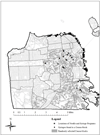A comparison of syringe disposal practices among injection drug users in a city with versus a city without needle and syringe programs
- PMID: 22209091
- PMCID: PMC3358593
- DOI: 10.1016/j.drugalcdep.2011.12.001
A comparison of syringe disposal practices among injection drug users in a city with versus a city without needle and syringe programs
Abstract
Background: The United States (U.S.) approved use of federal funds for needle and syringe programs (NSPs) in December 2009. This study compares syringe disposal practices in a U.S. city with NSPs to a U.S. city without NSPs by examining the prevalence of improperly discarded syringes in public places and the self-reported syringe disposal practices of injection drug users (IDUs) in the two cities.
Methods: We conducted visual inspection walkthroughs in a random sample of the top-quartile of drug-affected neighborhoods in San Francisco, California (a city with NSPs) and Miami, Florida (a city without NSPs). We also conducted quantitative interviews with adult IDUs in San Francisco (N=602) and Miami (N=448).
Results: In the visual inspections, we found 44 syringes/1000 census blocks in San Francisco, and 371 syringes/1000 census blocks in Miami. Survey results showed that in San Francisco 13% of syringes IDUs reported using in the 30 days preceding the study interviews were disposed of improperly versus 95% of syringes by IDUs in Miami. In multivariable logistic regression analysis, IDUs in Miami had over 34 times the adjusted odds of public syringe disposal relative to IDUs in San Francisco (adjusted odds ratio=34.2, 95% CI=21.92, 53.47).
Conclusions: We found eight-fold more improperly disposed syringes on walkthroughs in the city without NSPs compared to the city with NSPs, which was corroborated by survey data. NSPs may help IDUs dispose of their syringes safely in cities with large numbers of IDUs.
Copyright © 2011 Elsevier Ireland Ltd. All rights reserved.
Conflict of interest statement
All authors declare that they have no conflicts of interest.
Figures
References
-
- Alter MJ. Occupational exposure to hepatitis C virus: a dilemma. Infect. Control Hosp. Epidemiol. 1994;15:742–744. - PubMed
-
- Bluthenthal RN, Watters JK. Multimethod research from targeted sampling to HIV risk environments. NIDA Res. Monogr. 1995;157:212–230. - PubMed
-
- California Senate Bill 1159. Disease Prevention Demonstration Project, Vasconcellos, Statutes of 2004. 2004.
-
- City and County of San Francisco Department of Public Works. [Accessed on 9.7.11];Mechanical Street Sweeping Program. http://sfdpw.org/index.aspx?page=322.
Publication types
MeSH terms
Grants and funding
LinkOut - more resources
Full Text Sources


